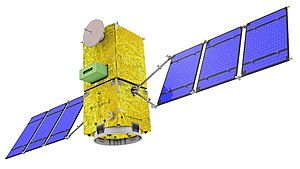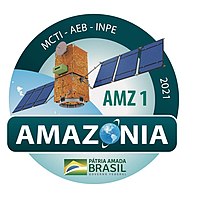The Amazônia-1 or SSR-1 (in Portuguese: Satélite de Sensoriamento Remoto-1), is the first Earth observation satellite developed by Brazil,[7] helped by Argentina's INVAP, who provided the main computer, attitude controls and sensors, and the training of Brazilian engineers,[8] and launched at 04:54:00 UTC (10:24:00 IST) on 28 February 2021.[9][10][11]
 Amazônia-1 coupled with Payload Module. | |
| Names | SSR-1 Satélite de Sensoriamento Remoto-1 |
|---|---|
| Mission type | Earth observation |
| Operator | INPE |
| COSPAR ID | 2021-015A |
| SATCAT no. | 47699 |
| Website | Amazon Mission |
| Mission duration | 3 years, 8 months and 15 days (elapsed) 4 years (planned) [1] |
| Spacecraft properties | |
| Bus | MMP |
| Manufacturer | INPE |
| Launch mass | 637 kg (1,404 lb) [1] |
| Start of mission | |
| Launch date | 28 February 2021, 04:54 UTC[2][3] |
| Rocket | PSLV-C51[4] |
| Launch site | First Launch Pad, Satish Dhawan Space Centre |
| Contractor | NewSpace India Limited[5] |
| Orbital parameters | |
| Reference system | Geocentric orbit |
| Regime | Sun-synchronous orbit |
| Semi-major axis | 7,127 km (4,429 mi)[6] |
| Eccentricity | 0.011083[6] |
| Perigee altitude | 748.6 km (465.2 mi)[6] |
| Apogee altitude | 764.4 km (475.0 mi)[6] |
| Inclination | 98.5089°[6] |
| Period | 99.8 minutes[6] |
| RAAN | 135.0747°[6] |
| Argument of perigee | 261.1190°[6] |
| Mean anomaly | 98.8578°[6] |
| Epoch | 28 February 2021 |
| Main camera | |
| Name | Advanced Wide Field Imager (AWFI) |
| Collecting area | 850 km (530 mi) |
| Wavelengths | VIS-NIR band |
| Resolution | 60 m (200 ft) |
 Amazônia-1 patch satellite | |
Operations will be joint with the China–Brazil Earth Resources Satellite program (CBERS-4) satellite.[12]
Background
editIn the early 1990s, the design of SSR (Satélite de Sensoriamento Remoto) satellites, Amazônia-1 precursor, was revised and Instituto Nacional de Pesquisas Espaciais (INPE) technicians proposed replacing the polar orbit by an equatorial orbit, and this proposal was accepted. That made sense at that time as Brazil already had polar orbit coverage with the CBERS satellites. SSR-1 suffered several delays, either by lack of resources, or bid disputes. The effective start only occurred in 2001, when a contract was signed for the development of a multi-mission platform specifically, at the time, for this purpose.
In 2001, a joint study between the INPE and German Aerospace Center (DLR) was published, found that most of the SSR-1 requirements can be met by two sensors: the Camera VIS / NIR and other MIR.[13] However, with the publication PNAE=(?) review in 2005, the SSR-1 ceased to be a priority.
Update
editBetween September and October 2012, a structural model of the Amazônia-1 satellite was subjected to a series of vibration test.
In the latest review of the PNAE, published in January 2013, the Amazônia-1 resurfaced with the same name, and even successors were planned (Amazon-1B in 2017 and Amazon-2 in 2018). However, with polar orbit as a design feature, the release dates of these satellites can not be met. The Amazônia-1 schedule is already delayed by two years.[14]
The satellite was originally supposed to launch on a Brazilian VLS-1 rocket, but the program was cancelled.
The satellite was successfully launched on 28 February 2021 aboard ISRO's Polar Satellite Launch Vehicle (PSLV-C51) from the First Launch Pad of Satish Dhawan Space Centre.[15][10][4] The cost of launch was nearly USD 26 million.[16]
Post-launch
editOn March 2, 2021, journalist and science communicator Salvador Nogueira reported that according to trackers in the United States, the satellite may be tipping over in its orbit, but that the situation wasn't irreversible.[17] This occurred after the satellite was put into "mission mode," which triggered a safety program where the satellite was in an attitude that ensured its solar panels were exposed to the Sun.[18] The journalist later posted on Twitter that the situation may be due to the satellite's release and that it had already been resolved, but is awaiting word from INPE.[19] Later Clezio di Nardin, INPE's director, confirmed that the satellite operates normally and is going through the qualification phase, which will last until March 15.[20] The position of Clezio di Nardin and of Marcos Pontes, Minister of Science, was that nothing unusual had happened.[18]
Features
editThe current design features are as follows:
- Orbit: Sun-synchronous orbit
- Period of Earth imaging: 4 days
- Optical sighting wide imaging (camera with 3 bands in the visible (VIS) and 1 band in the near-infrared (NIR))
- Observation range: 850 km (530 mi) [21] with 60 m (200 ft) resolution.
- Platform: Multi-Mission Platform (MMP)
- Weight: 637 kg (1,404 lb)
Instruments
edit- Advanced Wide Field Imager (AWFI), is a 60 m (200 ft) resolution camera.[22]
Amazônia-2
editThe Amazônia-2 satellite was planned for launch in 2022 to replace its predecessor.[23]
Gallery
edit-
Colored composition showing the Manuripi-Heath Amazon National Wildlife Reserve, in Bolivia.
-
Real color image showing the metropolitan region of São Paulo and its surroundings.
-
True color image showing the Sobradinho reservoir, Rio São Francisco, and its surroundings.
-
True color image of the city of Ibotirama, BA, the São Francisco River, and surroundings.
-
Colored composition showing the metropolitan region of Rio de Janeiro and its surroundings
-
Burketown, Australia on 12 May 2021
-
Ilha do Mel and Curitiba on 11 April 2021
-
Brasília on 11 April 2021
-
Sinop on 5 May 2021
See also
editReferences
edit- ^ a b "PSLV-C51/Amazonia-1 Brochure". ISRO. 23 February 2021. Archived from the original on 23 February 2021. Retrieved 23 February 2021.
- ^ "Lançamento do satélite Amazonia 1 adiado para o dia 28 de fevereiro". Retrieved 14 January 2021.
- ^ "Satélite brasileiro é embarcado para a Índia para lançamento". Retrieved 1 January 2021.
- ^ a b "ISRO to kick off 2021 by launching its first Indian start-up passenger into space aboard the PSLV-C51". Business Insider. 17 December 2020.
- ^ "PSLV-C51, the first dedicated launch by NSIL, successfully launches Amazonia-1 and 18 Co-passenger satellites from Sriharikota". ISRO. Archived from the original on 19 March 2022. Retrieved 28 February 2021.
- ^ a b c d e f g h i n2yo.com. "Amazonia 1". Retrieved 28 February 2021.
{{cite web}}: CS1 maint: numeric names: authors list (link) - ^ "Amazônia-1 será o primeiro satélite totalmente desenvolvido pelo Brasil" [Amazonia-1 will be the first satellite developed entirely by Brazil] (in Portuguese). 22 July 2008. Retrieved 9 April 2013.
- ^ ANIMUS (28 February 2021). "Se lanzó Amazonia-1, el primer satélite brasileño con componentes de INVAP". INVAP - Investigación Aplicada (in European Spanish). Retrieved 6 March 2021.
- ^ "Definido o lançamento do satélite brasileiro Amazonia-1 — Coordenação-Geral de Observação da Terra". obt.inpe.br. Archived from the original on 16 December 2018. Retrieved 16 December 2018.
- ^ a b "Satélite Amazônia-1 começa a ser fechado para a realização de testes ambientais". inpe.br (in Brazilian Portuguese). Retrieved 23 February 2020.
- ^ "Satélite de monitoramento da Amazônia deverá ser lançado em fevereiro" (in Brazilian Portuguese). Governo do Brasil. Retrieved 26 July 2020.
- ^ "Inpe adquire componentes para o satélite Amazônia-1" [INPE acquires components for the satellite Amazonia-1] (in Portuguese). Retrieved 9 April 2013.
- ^ Rudorff, Bernardo (10/04/2003), O SATÉLITE DE SENSORIAMENTO REMOTO SSR-1 PARA MONITORAMENTO DA AMAZÔNIA, INPE, Retrieved 15 May 2016
- ^ PROGRAMA NACIONAL DE ATIVIDADES ESPACIAIS 2012-2021 Archived 22 March 2016 at the Wayback Machine Brazilian Space Agency 22 January 2013 Retrieved 15 May 2016
- ^ "Amazonia-1 será lanzado en 2020" (in Spanish). LATAM Satelital. 11 May 2018. Retrieved 11 May 2018.
- ^ "Brazilian-made satellite begins deforestation monitoring mission". The Brazilian Report. 8 March 2021. Retrieved 6 April 2022.
- ^ "Satélite Brasileiro Amazônia-1 pode estar fora de controle, afirmam especialistas" (in Brazilian Portuguese). 3 March 2021. Archived from the original on 3 March 2021. Retrieved 3 March 2021.
- ^ a b "Depois de apuros em modo de 'sobrevivência', Amazônia-1 já faz imagens do Brasil" (in Brazilian Portuguese). 7 March 2021. Archived from the original on 8 March 2021. Retrieved 8 March 2021.
- ^ @salnog (3 March 2021). "UPDATE na história do Amazonia-1. PARECE que o caso da rotação anômala veio na liberação e agora já está estabilizado/recuperado. Mas seguimos aguardando manifestação oficial do Inpe" (Tweet) (in Brazilian Portuguese) – via Twitter.
- ^ Salvador Nogueira (3 March 2021). "Inpe diz que operação do Amazônia-1 está normal" (in Brazilian Portuguese). Archived from the original on 3 March 2021. Retrieved 3 March 2021.
- ^ "Spaceflight Awarded Contract to Launch Brazil's Amazonia-1 Spacecraft". Spaceflight.com. 18 December 2018. Retrieved 23 January 2020.
- ^ "The Ceos Database: Instrument Summary - AWFI". Database.eohandbook.com. Retrieved 8 March 2014.
- ^ "Plano Diretor 2011 - 2015" (PDF). Inpe.br. Retrieved 8 March 2014.